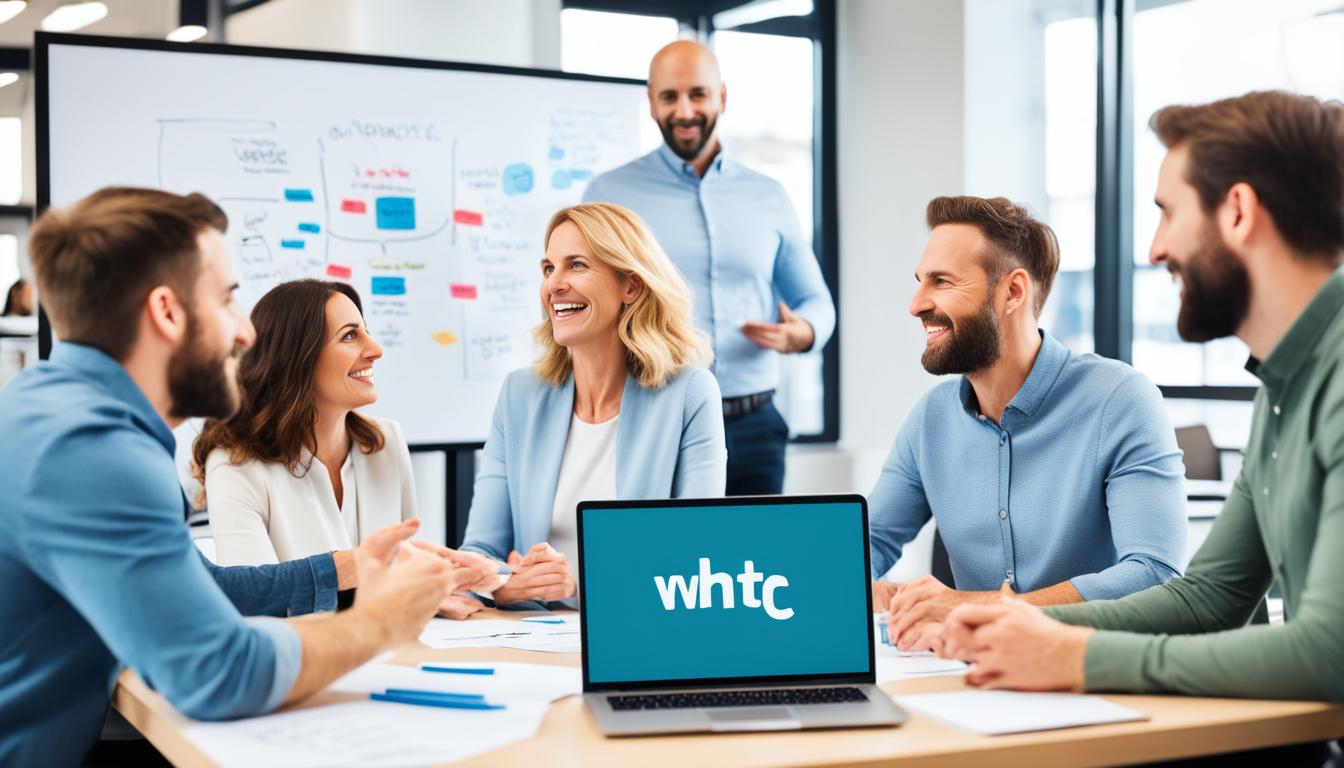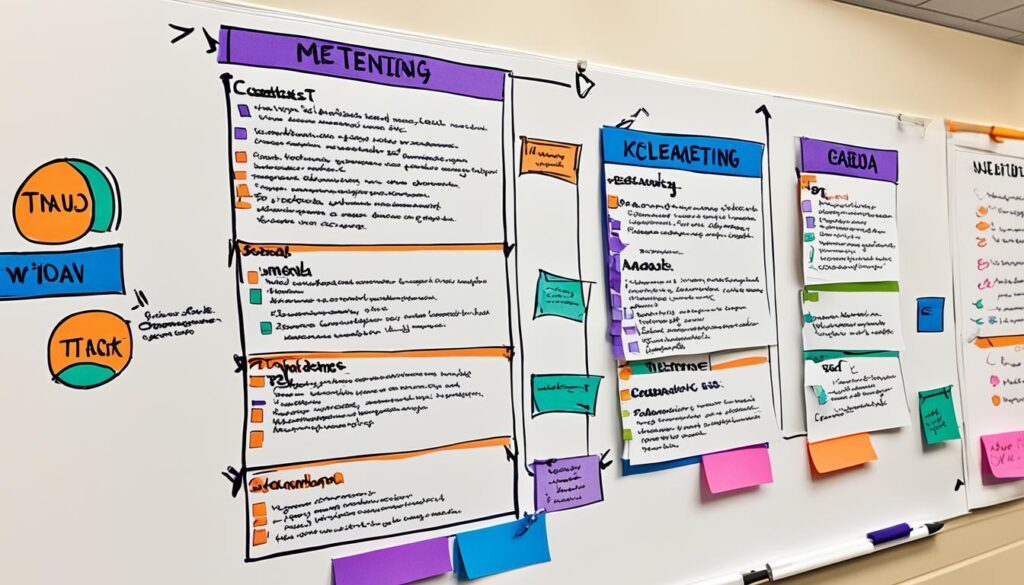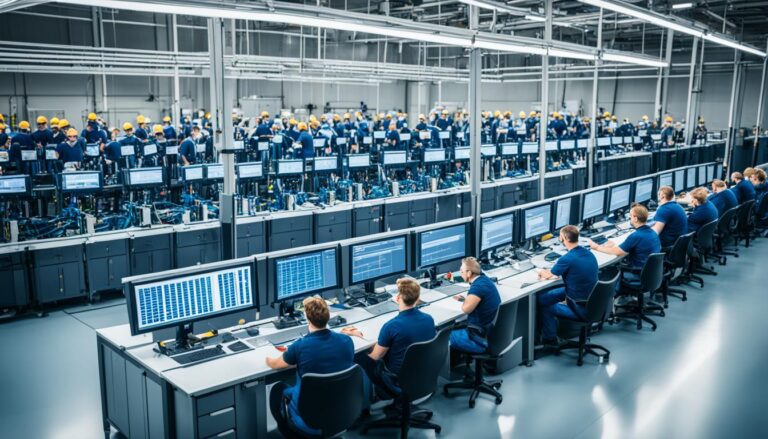Elevate Your Meetings: Best Practices for Success

Meetings are a fundamental aspect of any organization’s workflow. However, have you ever wondered why some meetings are unproductive while others are highly effective? What are the secrets to transforming your meetings into impactful events that drive success? In this article, we will explore best practices for meetings that will help you optimize your meeting outcomes and improve overall efficiency. Discover the strategies and tips that can elevate the effectiveness of your meetings and unlock the true potential of your team.
Key Takeaways:
- Setting a clear agenda is the foundation of a successful meeting.
- Invite the right participants who are directly connected to the meeting’s purpose.
- Foster open communication to ensure every voice is heard.
- Enhance team engagement through interactive methods.
- Address meeting fatigue by setting time limits and streamlining agendas.
Setting a Clear Agenda
A clear and well-defined agenda is vital for the success of any meeting. It helps participants understand the purpose of the meeting, keeps discussions focused, and allows for easy measurement of meeting outcomes. By setting a clear agenda, you can ensure that your meetings are productive, organized, and goal-oriented.
Here are key steps to follow when setting a clear agenda:
- Pre-plan: Take the time to plan the meeting in advance, considering its objectives and desired outcomes.
- Outline objectives and key topics: Clearly define the objectives you aim to achieve during the meeting. Identify the key topics that need to be discussed to accomplish those objectives.
- Allocate specific times: Assign specific time slots for each agenda item to ensure that discussions stay on track and the meeting remains focused.
- Distribute the agenda in advance: Share the agenda with participants ahead of time to give them an opportunity to prepare and contribute effectively during the meeting.
- Prioritize topics: Arrange the agenda items in order of importance, ensuring that the most critical topics are given due attention.
- Designate a facilitator: Appoint someone to lead the meeting, keeping discussions on track and managing the time effectively.
- Provide necessary materials: Ensure that participants have access to any materials or documents they may need to contribute to the meeting discussions.
- Encourage participation: Foster an environment where everyone feels comfortable and encouraged to actively participate in the meeting.
- Review previous meeting minutes: Take a few moments to revisit the minutes of previous meetings to provide context and continuity to current discussions.
- Define next steps: Conclude the meeting by clearly stating the next steps and any actions that need to be taken by participants.
By following these guidelines, you can ensure that your meetings have a clear direction and purpose, enabling you and your team to achieve the desired outcomes effectively.
Remember, a well-structured agenda sets the stage for a successful meeting, enhances collaboration, and contributes to overall team productivity.

Selecting the Right Participants
In order to ensure the success of your meeting, it is essential to carefully select the right participants. By inviting individuals who are directly connected to the meeting’s purpose and ensuring the presence of decision-makers, you can facilitate timely resolutions and drive productive discussions.
When selecting meeting participants, it is important to limit the number of attendees to promote effective communication. By keeping the group small and focused, you can encourage more meaningful contributions and interactions.
Consider incorporating remote participation options to allow for virtual attendance and contributions. This can broaden the pool of potential participants and improve the overall relevance and diversity of perspectives.
Clearly defining roles and responsibilities for each participant is crucial to minimize confusion and ensure that everyone understands their objectives. By communicating expectations and providing background information prior to the meeting, you can enable attendees to come prepared and contribute effectively.
Creating a respectful and inclusive environment is also essential when selecting meeting participants. Fostering a culture of open-mindedness and encouraging diverse perspectives can enrich discussions and lead to more innovative solutions.
Lastly, continually assessing the involvement and contribution of meeting participants is important. Regularly evaluate the value that each individual brings to the meeting and consider adjusting participant lists as needed to maintain productivity and relevance.
Key Factors for Selecting Meeting Participants
| Factors to Consider | Importance |
|---|---|
| Relevance to meeting purpose | High |
| Presence of decision-makers | High |
| Number of participants | Moderate |
| Remote participation options | Moderate |
| Clear roles and responsibilities | High |
| Respectful and inclusive environment | High |
| Assessment of involvement | Moderate |
Fostering Open Communication
Open communication is the key to unlocking the full potential of your team meetings. By creating an inclusive environment that values every team member’s input, you can drive collaboration and innovation.
To foster open communication in your meetings, consider implementing the following strategies:
- Encourage active participation from all team members, ensuring that every voice is heard.
- Use tools and techniques that facilitate open dialogue, such as round-robin discussions or brainstorming sessions.
- Promote active listening by providing opportunities for team members to share their perspectives and ideas.
- Create a respectful and safe environment where team members feel comfortable expressing their opinions.
- Encourage respectful debate and discussion to explore different viewpoints and find the best solutions.
- Avoid using jargon or technical terms that may exclude certain team members from fully understanding the discussion.
- Provide opportunities for shy or introverted team members to express themselves, such as through anonymous suggestion boxes.
- Summarize key points and decisions made during the meeting to ensure everyone is on the same page.
- Follow up with documentation, such as meeting minutes or action items, to reinforce accountability and provide a reference for future discussions.
By fostering open communication in your meetings, you can create a collaborative atmosphere that encourages diverse ideas, increases engagement, and drives innovation.

Enhancing Team Engagement
Engaging your team members is essential for creating productive and impactful meetings, especially in creative professions where collaboration and innovation are key. By incorporating interactive methods, you can transform ordinary meetings into engaging experiences that inspire and motivate your team.
Here are a few effective techniques for enhancing team engagement:
- Breakout sessions: Divide your team into smaller groups to encourage collaboration and generate new ideas.
- Gamification: Introduce game-like elements, such as quizzes or competitions, to make meetings more interactive and fun.
- Visual aids: Utilize visual materials like charts, graphs, or videos to enhance understanding and stimulate creativity.
- Hands-on participation: Provide hands-on activities or simulations to actively involve your team members in the meeting.
- Virtual engagement: Use online tools and platforms that allow remote team members to actively participate and contribute.
- Storytelling: Share compelling stories or case studies to inspire creative thinking and problem-solving.
- Creative expression: Encourage team members to express their ideas and opinions through different creative mediums like art or writing.
- Rotating facilitators: Rotate the responsibility of leading meetings among team members to promote active engagement and ownership.
- Real-world examples: Use real-life examples or case studies to illustrate concepts and spark discussions.
- Opportunities for reflection: Provide moments for individual reflection and personal insights during the meeting.
By implementing these interactive methods, you can create an engaging meeting environment that promotes active participation, collaboration, and creative thinking. Remember, when team members are engaged and inspired, the possibilities for innovation are limitless.

Addressing Meeting Fatigue
Meeting fatigue is a common issue that can hinder productivity and engagement. Long, inefficient meetings can leave participants feeling drained and disinterested. To combat meeting fatigue and ensure that your meetings are focused and effective, consider implementing the following strategies:
Set Time Limits for Meetings
One way to address meeting fatigue is by setting time limits for meetings and sticking to them. Longer meetings tend to be less productive and can lead to decreased engagement. By keeping meetings concise and time-bound, you create a sense of urgency and encourage participants to stay focused throughout the discussion.
Optimize Agendas
Shorter meetings are often more effective and engaging. To achieve this, streamline your meeting agendas by eliminating unnecessary discussions and focusing on the most important topics. Create a clear and structured agenda that outlines the key points to be discussed, ensuring that participants understand the purpose and desired outcomes of the meeting.
Utilize Meeting Management Tools
Meeting management tools, such as timers and time tracking apps, can help keep meetings on track and prevent them from running over time. Set timers for each agenda item to ensure that discussions stay on schedule and participants have sufficient time to address each topic. These tools can also help in effectively allocating time to each participant, ensuring that everyone gets an equal opportunity to contribute.
By addressing meeting fatigue through shorter, more focused meetings with streamlined agendas, you can optimize participant engagement and productivity. Let’s explore further best practices for successful meetings in the following sections.

Follow-Up and Documentation
Ensuring effective follow-up after meetings is essential for maximizing the impact and outcomes of your discussions. By sharing comprehensive meeting notes and maintaining open lines of communication, you can ensure that participants have a clear understanding of the key discussions and decisions made during the meeting.
Sharing meeting notes allows everyone to access and refer back to the important points that were covered. This serves as a valuable reference for future meetings and helps to maintain continuity and alignment within your team. Whether it’s a quick check-in or a detailed recap, documenting the meeting discussions and decisions provides a clear record of the outcomes.
To streamline the process of sharing meeting notes and information, consider using collaboration tools like Slack or other notes-sharing platforms. These tools make it easy to organize, store, and access meeting notes, ensuring that everyone has access to the necessary information. Additionally, it promotes transparency and accountability within your team.
Seeking feedback from meeting participants is an important part of the follow-up process. By asking for input and suggestions, you give everyone the opportunity to contribute their ideas and opinions, and identify areas for improvement. This feedback can then be used to refine future meetings and make them even more successful.
Ultimately, effective follow-up and documentation are essential for reinforcing the key takeaways from your meetings. By sharing information, maintaining transparency, and seeking feedback, you can ensure that your meetings are not just one-time events but rather valuable and ongoing conversations that drive alignment, collaboration, and success within your team.
| Benefits of Follow-Up and Documentation |
|---|
| 1. Ensures clear understanding of discussions and decisions |
| 2. Provides a reference for future meetings |
| 3. Promotes transparency and accountability |
| 4. Streamlines the process of sharing and accessing meeting notes |
| 5. Allows for feedback and continuous improvement |
Conclusion
Implementing best practices for effective team meetings is the key to driving productivity and fostering a positive work environment. By following these strategies, you can optimize your meetings and transform them into valuable and impactful events that drive success for your organization.
Start by setting clear agendas that outline meeting objectives and allocate specific times for each agenda item. This will keep discussions on track and ensure that everyone is focused and engaged. Additionally, carefully select the right participants who are directly connected to the meeting’s purpose and invite decision-makers to facilitate timely resolutions.
Fostering open communication is vital for creating an inclusive meeting environment. Encourage participation from all team members, practice active listening, and promote respectful debate. By doing so, you can enhance collaboration, creativity, and innovation within your team.
To further enhance team engagement, incorporate interactive methods into your meetings. Use breakout sessions, visual aids, and hands-on participation to make the meetings more engaging and enjoyable. This will foster active participation and inspire creativity among your team members.
Addressing meeting fatigue is crucial to maintaining productivity. Set time limits for your meetings, streamline agendas, and eliminate unnecessary discussions. By keeping meetings focused and concise, you ensure that participants stay attentive and productive throughout.
Don’t forget to follow up with meeting documentation. Share meeting notes to provide a reference for future discussions and decisions. Seeking feedback from participants will help you continuously improve your meetings and create a culture of appreciation.
By implementing these best practices and continuously optimizing your meetings, you can create a highly effective team that achieves outstanding results and drives success for your organization.






